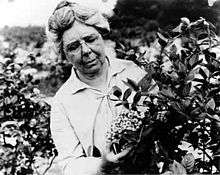Elizabeth Coleman White
Elizabeth Coleman White (October 5, 1871 – November 11, 1954) was a New Jersey agricultural specialist who collaborated with Frederick Vernon Coville to develop and commercialize a cultivated blueberry.[1][2][3]
Elizabeth Coleman White | |
|---|---|
 | |
| Born | October 5, 1871 |
| Died | November 11, 1954 (aged 83) Whitesbog, New Jersey |
| Parent(s) | Mary Fenwick Joseph Josiah White |
| Relatives | Barclay White, grandfather |
Biography
Elizabeth Coleman White was born on October 5, 1871 in New Lisbon, New Jersey. She was the oldest of four daughters of Quaker parents, Mary A. Fenwick and Joseph Josiah White. Elizabeth graduated from the Friends' Central School in Philadelphia, Pennsylvania in 1887.[2]
After 1887 she worked in the bogs helping to supervise cranberry pickers at her father's farm. During the winters, White continued her education with courses in first aid, photography, dressmaking, and millinery at Drexel University. White belonged to several organizations, including being the first woman to become member of the American Cranberry Association and the first woman to receive a citation from the New Jersey Department of Agriculture.[4]
In 1927 she helped organize the New Jersey Blueberry Cooperative Association.[2]
White died of cancer in Whitesbog, New Jersey, on November 27, 1954, at the age of 83. She was cremated at Ewing Crematory in Ewing Township, New Jersey. Her ashes were distributed by airplane over the headwaters of Whitesbog in accordance to her will.
Child labor controversy
In 1910, a controversy arose when an agent of the National Child Labor Committee (NCLC) issued a report of child labor in the cranberry industry. As one third of the cranberry farms was harvested by J.J. White Inc., Elizabeth White wrote letters and spoke out against the report, defending her father's company and industry. The argument of NCLC investigators was that parents recruited their children under the age of 14 to work ten-hour shifts. White argued and reported that children played in the clean air and would gladly work at the request of parents. The controversy continued for four years until the NCLC printed a retraction in The Trenton Times and acknowledged White's efforts as peacemaker. White also conceded that children missed school between the months of September and October due to the harvest, and believed in an informal education for those who missed school due to this reason. White worked with the Women's Home Mission Council to provide babysitting services for younger children and informal educational and recreational programs for older ones.[5]
References
- "Elizabeth Coleman White". Burlington County Times. March 6, 2005.
Elizabeth Coleman White (1871-1954) developed the first marketable blueberry in 1916. She was the daughter of JJ White, who in the early 1900s operated the ...
- "Distinguished Women of Past and Present: Elizabeth Coleman White". Distinguished Women. Retrieved 2008-03-20.
- "How New Jersey Tamed The Wild Blueberry For Global Production". National Public Radio. August 4, 2015.
- Parrott, Charles. "The Woman Who Cultivated a Billion-Dollar Industry". United States Department of Agriculture.
- Knackmuhs, Ginny. "The Blueberry: Born & Bred in New Jersey" (PDF). Archived from the original (PDF) on November 13, 2014. Retrieved May 6, 2015.
Further reading
- White, Elizabeth (July 6, 1937). "Taming Blueberries" (PDF). Garden Club of New Jersey: Radio Garden Club. Mutual Broadcasting. WOR. Archived from the original (PDF) on November 29, 2014. Radio Garden Club, Volume 6, Digest No. 50, New Brunswick, N.J. Retrieved November 12, 2014.
- White, Joseph J. (2009) [1870]. Cranberry Culture. New York: Orange Judd & Co. (Digitized by the University of California Library)